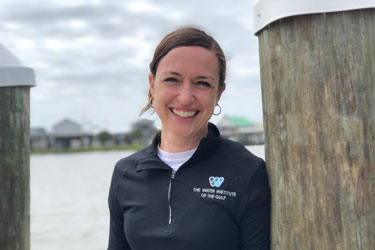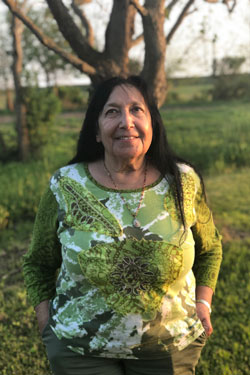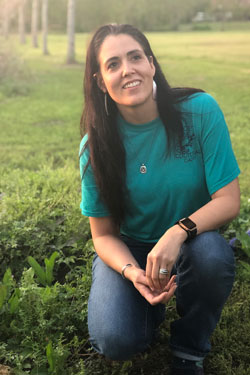Women of the Bayou: Stories of resilience and ingenuity in south Louisiana’s changing landscape
Over the past 25 years, the southern Louisiana coastline has been disappearing at an average rate of almost a football field every hour. With these immense losses, it’s easy for people both in and outside the region to lose hope. Many across the country write off the area completely, concluding that folks should pack up and move north. But for the locals who live and work in the bayou, who have lived in the nooks and crannies along the marshes for generations, it’s home.
Women who live and work along the bayou have played an integral role in keeping the culture alive in this area. We had the chance to interview a few about what it means to be a “Bayou Woman.” These are not stories of doom and gloom for the region. These are stories of hope, ingenuity, and resilience in times of adversity.
Melissa Baustian, Ph.D
Water Institute of the Gulf
Melissa Baustian, Ph.D, is a coastal ecologist for The Water Institute of the Gulf. She has lived and worked in Louisiana for 10 years. In that short time span, she has seen major change in the region.
“Coastal Louisiana is a low-lying, deltaic ecosystem, and so our land is sinking, and our seas are rising. We have a huge challenge of how we are going to protect people and the environment from rising sea levels.”
But, an increase in scientific literacy in the community gives Baustian hope for the place she has come to call home.
“I’ve seen the community of research scientists really grow. I think environmental literacy is gaining popularity in coastal Louisiana because it’s very real here – we really depend on our coast and we need to defend and restore it,” she says. “I have seen more people understanding the issue.”
Teresa Dardar
Pointe-Au-Chien Indian Tribe Member
Teresa Dardar has lived in Pointe-au-Chenes for half of her life and she wouldn’t have it any other way.
She remembers going shrimping with her husband Donald in the 70s. When they were all done for the day, she would make the drive back while he tidied the boat. The tiny marsh islands and ponds served as her landmarks. She knew her way.
In just four decades, she has seen her landmarks sink beneath the brackish water. She can’t imagine making the drive back without exact GPS points. But still, she’s hopeful for the future.
Dardar has been working with other women in the tribe to plant community gardens and elevated greenhouses. In addition to vegetables, they will grow traditional medicinal plants that have used by the tribe for generations.
The plants used to grow in the wild, but they have gotten harder to find.
“With sea-level rise, we get saltwater and that’s what killed all our plants. People are afraid to plant gardens because of saltwater intrusion,” she says.
When asked what gives her hope, she says, “People here are fighters. They’re determined to stay, and they’re determined to adapt to whatever way they need to. So, I think they give each other hope.”
Patty Ferguson-Bohnee
Pointe-Au-Chien Indian Tribe Member
Patty Ferguson-Bohnee is a member of the Pointe-au-Chien Indian Tribe, an attorney, and a clinical professor of law. She is helping her tribe advocate for recognition by the federal government. To date, the tribe is only recognized by the state of Louisiana.
“Federal recognition is really about acknowledging who we are and that we have a right to be here and a right to protect the land, a right to for others to acknowledge that we should be here,” Ferguson-Bohnee says.
The tribe’s land is facing land loss, increasingly intense storms, and disturbance by oil companies, but Ferguson-Bohnee still has hope for the future.
She sees her fellow tribal members adjusting to the new state of their land by building gardens and working together for food security.
“We’re an adaptable culture – we’ve lived further down the bayou than where we are now. We’ve always been self-sufficient, so we need to continue to do that and find ways to ensure that our life ways will continue,” she says.
The Pointe-au-Chien Indian Tribe has decided to stay on what remains of their ancestral lands as opposed to resettling.
“Everybody has a responsibility to other people in the community and you can only have that if you’re close within your community,” she explains. “That’s why it’s so important to try to adapt rather than resettle or relocate further away. People want to maintain those kinship ties.”
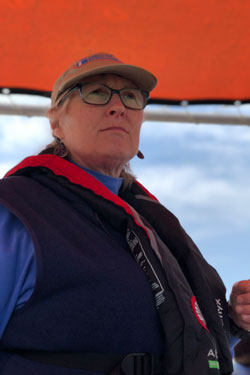 Denise Reed
Denise Reed
University of New Orleans
Denise Reed, PhD, says her accent reflects both her childhood in the UK and her adult life in coastal Louisiana. As the water rises, Reed sees more reasons to move away from her home in Louisiana, but she has no plans to leave.
“I could have gone to work elsewhere in the country and probably still could,” she says. “But my husband’s family is still here. I married a man from Louisiana, my kids are very much south Louisiana kids, they’re very proud of where they went to school.”
As sea-level rise increases, Reed sees adaptation as the only way forward for the coastal community in which she lives.
“We need to really be that example for the rest of the country about how to [adapt] and to some extent I think that means that the rest of the country should be looking to us to help us think about how to do that. And not just writing us off. Because if you write off coastal Louisiana, you write off south Florida, you write off low-lying parts of North Carolina, you write off huge areas of the Gulf Coast and Texas.”
The increase in levees around Terrebonne Parish are one part of this adaptation. Levees decrease the risk of flooding and property damage during tropical storms.
“If there is a big hurricane, we’re still going to get wet,” Reed acknowledges. “But we have a little bit more protection than we had previously, and I think that provides an assurance to people.”
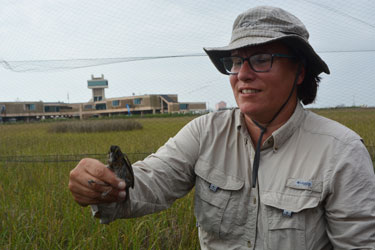 Delaina LeBlanc
Delaina LeBlanc
Barataria Terrebone National Estuary Program
Delaina LeBlanc, a Louisiana native, sees change along coastal Louisiana every day in her job as the migratory birds coordinator at the Barataria Terrebonne National Estuary Program.
“You have tidal influence with winds, just this perfect combination, things can change drastically,” LeBlanc says.
She recalls a day in the field shortly after the Deepwater Horizon oil spill. She spotted a large tar ball. She thought she might want to collect it but figured she could wait until the next day. But when she returned, it was gone.
“So those are dynamic changes you find just with watching the landscape.”
LeBlanc said the strength of the Cajun culture is what gives her hope for the future.
“They have figured things out,” she says. “Mentally they are present in such a way that they don’t stop. No one’s resting on their laurels here. There’s always this component where the people just figure it out.”
And that’s just what LeBlanc did. She didn’t have a traditional science background, but knew she had a love for the land and for birds. She said she got her job by showing up and being dependable. She said most of the women in the bayou are fearless in that same way.
“I think women lead in a way where they’re actually doing,” she says. “They’re starting to make things tangible,” finding new ways to educate the public and bring attention to the challenges coastal Louisiana is facing. “The how-to is I think something that we really need, and I think women are really bringing that component to anybody and everybody.”
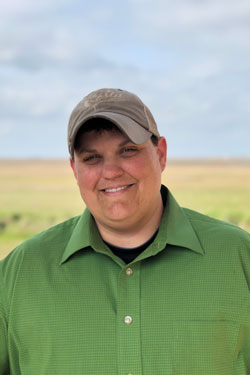 Beth Guidry
Beth Guidry
Ellender Memorial High School
Beth Guidry’s grandmother often spoke to her in French. But, much like the land, the French culture could very well be lost before Guidry can share it with her children.
“As I see the land change, I sometimes I wonder if my grandkids or my great-grandkids will actually be able to come and fish,” Guidry says. “They’ll be able to fish, but are they going to be stopping in Houma, and that’s the end of the bayou, or are they going to be able to come down here?”
As a science teacher at Ellender Memorial High School, Guidry knows the risks facing her home, but chooses to stay. “You’re not going to separate California because they keep having earthquakes. Why stop fighting for this place when we offer so much?”
Part of what gives her hope are the women who live along the bayou. “I think women nowadays are still great teachers. They’re great. They’re strong. You don’t want to mess with them.”
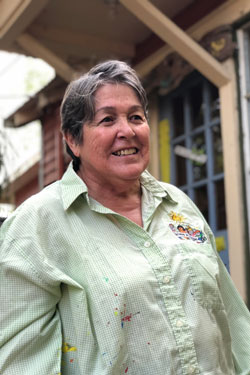 Dot-tee Theriot Ratcliff
Dot-tee Theriot Ratcliff
Art Gecko
Dot-tee Theriot Ratcliff, a retired preschool teacher and artist in Cocodrie, Louisiana, first noticed the drastic change her community was facing when she saw a fiddler crab crossing her driveway. She panicked. “You don’t belong here, you belong 25 miles down the road, buddy,” she said to the crab. She notes that recently, everything about the environment is in flux.
“The animals have changed, the plants have changed, the marsh has changed, the soil has changed.”
Despite the rapid environmental shifts, Ratcliff tries to keep her Cajun culture alive with her art, which includes a painting series featuring two pink alligators. She is trying to show that, “it’s okay to be a Cajun. It’s okay to be ‘down the bayou.’” She adds, “Yes, we’re different. It’s my culture. That’s the way it is. I will not change and that’s the way we are.”
Ratcliff says that the women in her community aren’t afraid to fix their roofs when hurricanes come, crew their crab and shrimp boats, or walk next to alligators along the bayou. “Cajun women can do just about anything, and we’re not scared to get our hands dirty.”
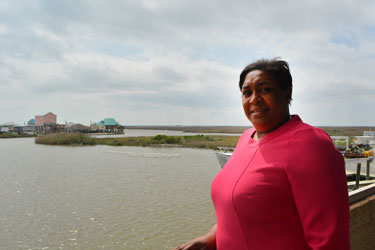 Arlanda Williams
Arlanda Williams
Terrebonne Parish Council
Arlanda Williams grew up in Terrebonne Parish next to a graveyard that also served as the kids’ playground. Today, she is a powerful voice on the Parish Council. She is living proof for one of her favorite phrases: “Your zip code does not determine your destination.”
Now, her leadership is needed more than ever, as at least five communities in the region are projected to become unlivable over the next 50 years. Williams is committed to finding funding sources for coastal restoration and resilience.
She feels hopeful that upcoming projects will slow the loss of land in her parish.
“We’ve been inundated by flood waters, our ecosystem is in trouble, but the solutions are coming. All the pieces of the puzzle are on the table,” she says, referring to the “puzzle” of creating resilient coastal communities. “We need to start doing things and take coastal restoration to a whole different level.”
But to Williams, that doesn’t mean we should focus on the “doom and gloom” of the situation. Instead, she is focused on solutions.
“This area, this parish is resilient,” she says. “I see a positive future for us because most of us were born and raised here, our parents were born and raised here, we’re raising our children here. But the difference here is our children are leaving, learning, and then coming back, and lending support to the vision and the growth of this parish.”
And women, Williams said, play an integral role in keeping the survival of this region.
“A bayou woman is a woman of strength and courage,” she says. “When the floods come, we’re the ones that stay up late at night to make sure when the water rises that the children are going to be okay. A bayou woman is someone who has resiliency, but she also has class and sophistication while doing it, and important knowledge on others to help grow them in times of storm.”
This story was created from OCEANDOTCOMM and supported by the Louisiana Universities Marine Consortium (LUMCON). It was produced by Michelle Barboza-Ramirez, Becca Burton, Melissa Cronin, M.B. Humphrey, Gabi Serrato Marks and Elizabeth Weinberg.

